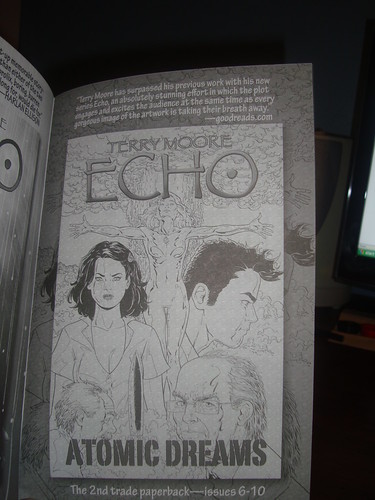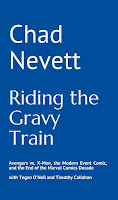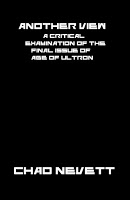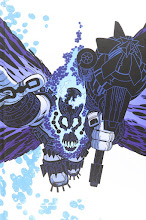In my discussion of V for Vendetta with my students over the past week that I've been teaching it, a few interesting thoughts came up that I thought I'd share with you.
+In comparing V to Rorschach, we talked about how Rorschach is defined very much by his sense of right and wrong. However, it's established very early on that V is a sociopath. Now that diagnosis comes from agents of the all-powerful government (such as Delia Surridge) but it is apt nonetheless. Beyond simply taking life with no qualms, he manipulates individuals (Rose, Evey) in horrific ways to meet his own ends and sees no value in them as individuals, only as organisms that are a part of the society as a whole.
Thus as a sociopath, V doesn't really have a sense of right and wrong. However he does have a sense of good or bad, I think, and he sees that the government as led by Susan is BAD because of how it impinges on its citizens' freedoms. Valerie is one of the only people he shows genuine feeling for, but I suspect that is more due to what she represents (what society has lost) than her own personal struggle.
(Meanwhile Evey IS touched by Valerie's story on a personal level, and one main reason behind V's torture of her (be it to educate or to indoctrinate her, depending on your POV) is to test her reaction to Valerie's letter, to measure her humanity. Evey learning what lesson V wanted her to learn, that her integrity and personal beliefs are more valuable than anything else, when she had been driven by the state of the world to the brink of betraying those beliefs (and killing someone) proved to him that she would be a worthy successor, the creator to follow him in the role of destroyer.)
Anyway, this led to me arguing that V's vendetta against those in power was not personal in any way and in fact, had the end result of his own torture and pain in Larkhill actually bettered society in some way, I would argue that he might have stopped at the end of book one, only revenging himself upon those who directly harmed him and leaving the society intact. But because the government is corrupt, he plays a different role. He sees the flaws in the way the world is run and he must point them out. He must fight to save the world from itself. It is here that V shares a commonality in his personality with Rorschach (and Ozymandias, but we'll get back to him in a moment).
Also, I find he is similar to Rorschach in his self-knowledge. Both characters, in my opinion, know that in order to clean up the cesspool of the society in which they live they must cross over a line. By crossing that line into "wrong" or "bad" behavior, they also recognize that any better world that might come to pass cannot have a place for them in it.
+Meanwhile, V as compared to Ozymandias is very similar in overall methodology. Both recognize that the ends justify the means, and both are willing to deal a little death in order to bring about a better society for all. Again, what V does to Rose, how he sets her up to get dragged through the mud so much that she will assassinate Susan, despite what it means to her own well-being, is perhaps his most reprehensible action in the book, very much akin in my mind to Ozymandias poisoning his faithful servants (and then later claiming no responsibility for that act).
However, I believe one key difference is that V does NOT harm unnecessarily. He could kill the train conductor when he kidnaps Prothero or the guard who finds Prothero, but he doesn't. Nor does he harm Finch, beyond a flesh wound to the leg, when Finch attacks him in the subway in the end. He only kills when he must, and never to hide his actions in a cowardly way. In fact, he wants it to be known what he's doing from the get-go. Meanwhile Ozymandias kills many people for the sole reason of covering his own tracks, when their deaths are completely unnecessary in bringing about his better world.
And I think this difference is essential in the end result of the book for both characters. V knows that he should not be a part of the new world order, that he has merely been an agent of destruction and that the rebuilding process should not involve him in any way. He was up front from the beginning about his role in the destruction of the old way of doing things, because he knew he would not survive and he wanted the new world to be chosen by the people themselves (thus why Eve as V lets the people riot on their own, thus why it's so important that ROSE kills Susan and FINCH kills V, since they are agents of the people and not individuals, thus why Eve/V abducts Dominic to educate him (the new senior authority) in the right way to create a new society).
Yet Ozymandias wants to rebuild the world in his own image, and his desire to change things for the better is all about HIS will (as established in the Veidt Method pamphlet), his selfish desire to outshine Alexander the Great and conquer the world (as established in his origin story outlined in issue eleven.
So it was our belief in the class that V would be at odds with Ozymandias for the harm he did and for his egotistical desires to be in power afterward, whereas Rorschach he would have no problem with, as long as Rorschach didn't get in his way. On the other hand, Rorschach would probably diametrically oppose V's actions, while Ozymandias would look at the end results of what he had plotted out and view him as a kindred spirit.
+One interesting contrast we found in the book is how in the beginning of the book the voice of Fate changes after Prothero's mental break, and everyone takes notice. The voice of Fate is the symbol of security in the government; it is everpresent and thusly taken for granted by those who hear it day in and day out, until the moment it changes. The change rocks the world of the people, casts doubt on security, shows the system is fallible.
On the other hand the voice of V changes in the end of the film. Whenever Eve takes over the role of V, and delivers the final address to the people of London, her voice must sound different than the original V's did. BUT no one takes note of that fact, because despite the nature of V as a symbol of what they've lost, they're actually listening to what V has to say. They don't care about the delivery, only the content, and thus take no note of a difference.
I just find that an interesting contrast.
+Of course we talked a great deal about how Evey can be viewed as the real protagonist of the series (since V himself is not a man but an idea, a symbol) and her growth from youth to adolescent to adult, from Evey to Eve to V, is what the book is really about.
And that naturally led to a detailed discussion of the changes made to the story in the film, for which I owe Kate McClancy much thanks for providing me with a copy of her essay which she presented at Wondercon this past February. We talked about how V in the film IS a man, how his humanity is emphasized repeatedly and how his love for Evey diminishes her character to mere love interest rather than disciple. V in the film tortures her, which she judges monstrous, showing him the error of his ways. The government must still be brought down because of how they have wronged him, but he realizes his methods are wrong now even though it is too late to turn back.
Rereading that essay by Kate solidified several issues in my mind, which I highlighted as we spent an entire class period looking at individual scenes from the film (the Larkhill scene, the TV hijacking, Valerie's letter, and the last twenty or so minutes of the film, from Sutler's death to V's to the march on Parliament), pausing between bits to discuss how the changes affected the characters and theme.
In all, the past two days of analysis of this great graphic novel have been very insightful, not just for my students but for me as well. It was a true delight how I could still find new and intriguing things in this book, even after having read it what must be somewhere between 25 and 50 times.
 I recently reviewed Dark Avengers #4 for CBR and, in the process, wrote the following sentences: "After Dark Avengers #3 went to a second printing, Marvel quoted my review of that issue, where I wrote, 'This is Bendis at his best... a must read each month.' That may have been true last issue, but not so here. Now it’s more 'This is Bendis writing a comic book that you can read each month if it ships on time... I mean, it’s an okay read, not too bad, but it’s not going to set the world on fire or anything.' There’s a quote that will move comics, don’t you think?"
I recently reviewed Dark Avengers #4 for CBR and, in the process, wrote the following sentences: "After Dark Avengers #3 went to a second printing, Marvel quoted my review of that issue, where I wrote, 'This is Bendis at his best... a must read each month.' That may have been true last issue, but not so here. Now it’s more 'This is Bendis writing a comic book that you can read each month if it ships on time... I mean, it’s an okay read, not too bad, but it’s not going to set the world on fire or anything.' There’s a quote that will move comics, don’t you think?"































